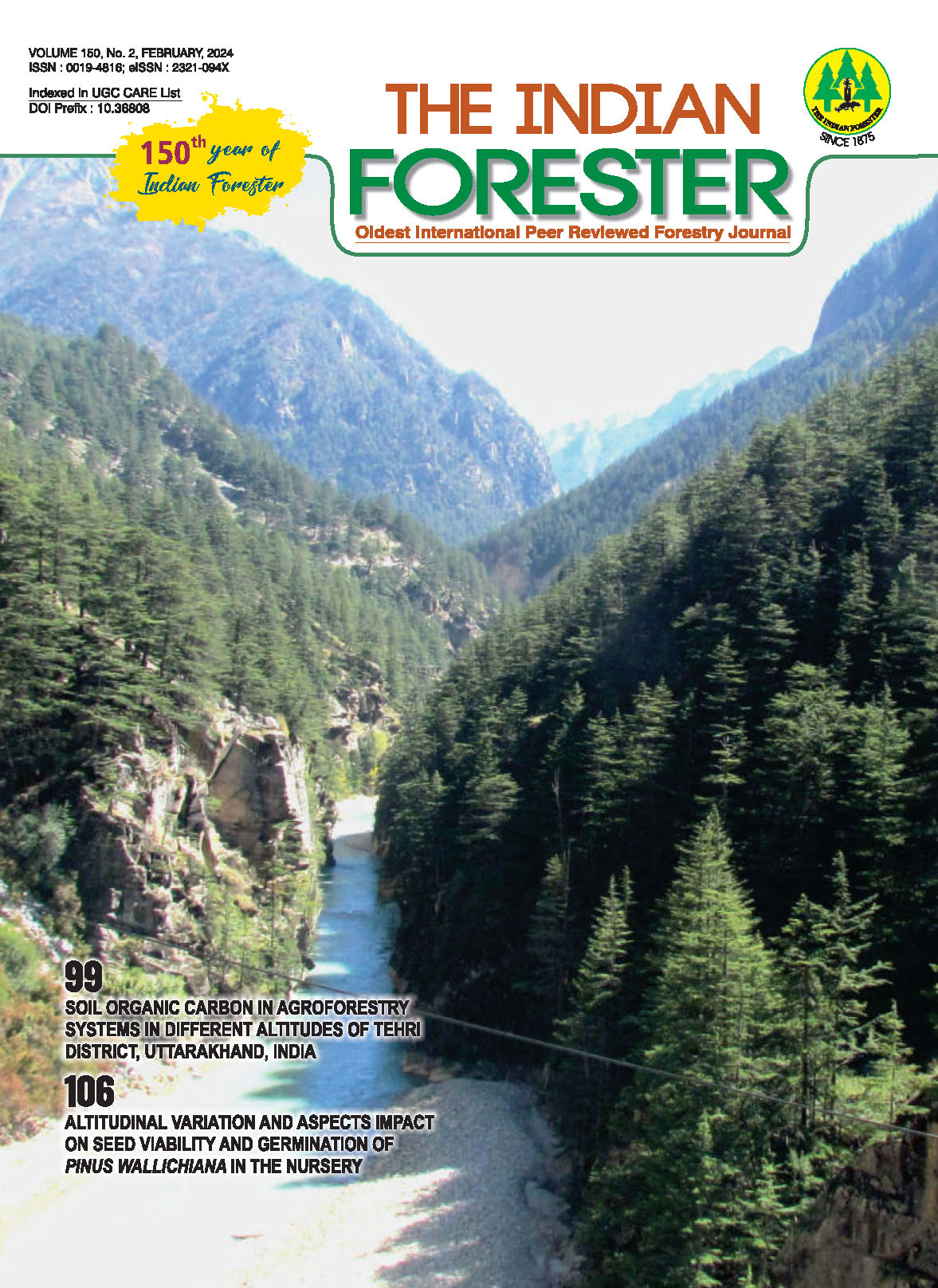Preparation of an Encapsulated Seed for the Preservation of Aquilaria malaccensis Seed
DOI:
https://doi.org/10.36808/if/2024/v150i2/169802Keywords:
Aquilaria malaccensis, Tetrazolium Chloride, Trypan Blue, Encapsulated, Non-Encapsulated.Abstract
The main objective of the study is to understand the seed viability of Aquilaria malaccensis using 2,3,5 tetrazolium chloride (TTC) based assays and trypan blue. The effects of storage of encapsulated and non-encapsulated seeds stored for 0, 15, and 30 days were also studied. After storing the samples were stained with 2,3,5 tetrazolium chloride assays and trypan blue. It was found that the encapsulated seeds (4 % sodium alginate) stored at 4° C and 25° C for 15 and 30 days show a high potential in terms of viability compared to the seed encapsulated with 6% sodium alginate and un-encapsulated seeds. It was also observed that the non-encapsulated seeds stored at 4° C revealed high viability compared to seeds stored at 25° C. Tetrazolium chloride assay is more accurate and stable for seed viability compared to trypan blue assay. However, it was found that encapsulation and temperature play a vital role in maintaining the viability of the seeds. Hence this technique can be used for the conservation, maintenance, and regeneration of A. malaccensis and various species through seed encapsulation.References
CITES (2005). Convention on International Trade in Endangered Species of Wild Fauna and Flora Appendices I, II and III of CITES. UNEP48.
Comas L.H., Eissenstat D.M. and Lakso A.N. (2000). Assessing root death and root system dynamics in a study of grape canopy pruning.New Phytol., 147: 171–178. doi: 10.1046/j.1469-8137.2000.00679.x.
Devi S.D., Kharsahnoh B., Kumaria S. and Das M.C. (2018). Artificial seed for short-term storage: Using nodal buds in Aquilaria malaccensis Lam. Curr. Sci., 115: 2103–2109.
Gantait S. and Kundu S. (2017). Artificial Seed Technology for Storage and Exchange of Plant Genetic Resources. In: Advanced Technologies for Crop Improvement and Agricultural Productivity (CP Malik, SH Wani, HB Kushwaha, R Kaur). Agrobios (International), Jodhpur (India), pp. 135-159".
Lopez Del Egido L., Navarro-Miró D., Martinez-Heredia V., Toorop P.E. and Iannetta P.P.M. (2017). A spectrophotometric assay for robust viability testing of seed batches using 2,3,5-Triphenyl Tetrazolium Chloride: using Hordeumvulgare L. as a model. Front. Plant Sci., 8: 747. doi: 10.3389/fpls.2017.00747
Maqsood M., Mujib A. and Siddiqui Z.H. (2012). Synthetic seed development and conversion to plantlet in Catharanthusroseus (L.) G. Don. Biotechnology, 11(1): 37-43. http://dx.doi.org/10.3923/biotech.2012.37.43.
Mohanrah R., Ananthan R. and Bai V.N. (2009). Production and storage of synthetic seeds in CoelogynebreviscapaLindl. Asian Journal of Biotechnology, 1(30): 124-128. https://dx.doi.org/10.3923/ajbkr.2009.124.128.
Murashige T. and Skoog F. (1962). A revised medium for rapid growth and bioassays with tobacco tissue cultures. Physiologia Plantarum, 15: 473–497
Oldfield S., Lusty C. and MacKinven A. (1998). The world list of threatened trees. World conservation press.
Phanomchai S., Bodhipadma K., Noichinda S. and Leung D.W.M. (2022). Short-term storability of alginate-encapsulated Persian violet micro shoots for germplasm exchange. Plants, 11(2): 185. https://doi.org/10.3390/plants11020185.
Ruf M. and Brunner I. (2003). Vitality of tree fine roots: reevaluation of the tetrazolium test. Tree Physiol., 23: 257–263. doi: 10.1093/treephys/23.4.257.
Saikia P. and Khan M.L. (2012). Phenology. Seed biology and seedling survival and growth of Aquilaria malaccensis; Ahighly exploited and red-listed tree species of Northeast India. Indian Forester, 138: 289-295.
Sankara Rao K., Raja K., Swamy, K., Kumar D., Singh R.A. and Bhat K.G. (2019). Flora of Peninsular India. Available in http://flora-peninsula-indica. ces. iisc. ac. in/herbsheet. php.
Shankar U. (2012). Effect of seed abortion and seed storage on germination and seedling growth in Aquilaria malaccensisLamk (Thymelaeaceae).Current Science, 102(4): 596-604.
Shimomura N. and Hasebe K. (2004). Estimation of viability of inner bark tissue of Quercusserrata, a substrate for log cultivation of Lentinula edodes, using the TTC assay method. Mycoscience, 45: 362–365. doi: 10.1007/S10267-004-0188-6.
Tabin T. and Shrivastava K. (2014). Factors affecting seed germination and establishment of critically endangered Aquilaria malaccensis (Thymelaeaceae).Asian Journal of Plant Science and Research, 4(6): 41-46.
Tnah L.H., Lee C.T., Lee S.L., Ng K.K., Ng C.H., Nurul-Farhanah Z., Lau K.H. and Chua L.S. (2012). Isolation and characterization of microsatellite markers for an important tropical tree, Aquilaria malaccensis (Thymelaeaceae). American Journal of Botany, 99(11): e431-3. DOI: 10.3732/ajb.1200165.
Venugopal N. and Marbaniang E.J. (2017). Phenology, pollination mechanism, breeding system, seed dispersal and germination in Aquilaria malaccensis Lam. a threatened tropical evergreen forest tree of North East India. The International Journal of Plant Reproductive Biology, 9(2): 129-138.
Downloads
Downloads
Additional Files
Published
How to Cite
Issue
Section
License
Unless otherwise stated, copyright or similar rights in all materials presented on the site, including graphical images, are owned by Indian Forester.





